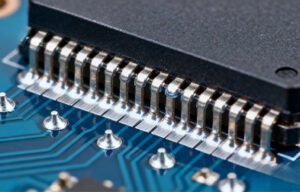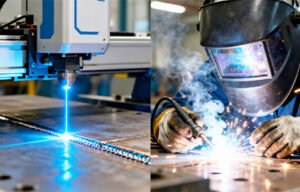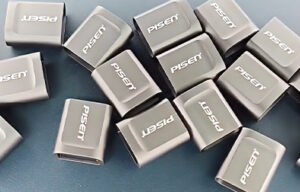How to Weld Thin Metal Without Deformation Using Laser Welding Machines
Thin metal welding is one of the most delicate processes in modern manufacturing. The thinner the material, the more likely it is to warp, distort, or burn through. However, with the right techniques and laser welding equipment, it’s possible to weld thin metal as slim as 0.2 mm or 0.3 mm — without deformation.
In this guide, we explore how laser welding machines enable clean, strong, and distortion-free welds on thin metal, and how you can achieve the best results in your own production line.
Introduction: The Challenges of Welding Thin Metal
Welding thin metal presents several difficulties:
Heat distortion and warping
Burn-through due to excess energy
Inconsistent penetration depth
Structural weakness from overheating
Traditional methods like TIG or MIG welding often apply too much heat or lack the precision needed. That’s where laser welding comes into play.
Why Laser Welding Is Ideal for Thin Metal
Laser welding offers unique advantages for handling thin or sensitive materials:
Low heat input: Reduces risk of thermal distortion
High precision: Allows micron-level control of weld seams
Small heat-affected zone (HAZ): Maintains material properties
Non-contact process: Reduces mechanical stress
Laser welding uses concentrated energy to create a deep and narrow weld, ideal for thin materials like stainless steel, aluminum, and nickel alloys.
Key Factors That Affect Thin Metal Deformation
To understand how deformation occurs during welding, it’s important to consider:
Material Thickness: The thinner the metal, the more susceptible it is to heat-related warping.
Heat Input: High energy over a long period will cause expansion and distortion.
Joint Design: Poor fit-up increases the chance of burn-through.
Welding Speed: Slower speed = more heat = more distortion.
Clamping or Fixturing: Inadequate clamping can allow movement during welding.
How Laser Welding Machines Prevent Deformation
Modern laser welding systems, especially fiber laser welding machines, provide:
Ultra-focused beams: Targeted energy prevents excessive heat spread.
Adjustable pulse settings: Ideal for thin materials by reducing continuous heat application.
Real-time monitoring: Automated control of power, speed, and focus.
Non-contact welding: Eliminates pressure points or fixture misalignment issues.
Fiber lasers with powers between 100W to 1000W are typically used for thin metal processing. For example, a 300W pulsed fiber laser can handle metals as thin as 0.2 mm.
Best Practices for Welding Thin Metal with Lasers
To achieve perfect welds without distortion, follow these tips:
Optimize Power and Frequency: Use pulsed lasers for better control on thin sheets.
Control Focus Position: The beam should focus slightly below the surface to avoid burn-through.
Choose the Right Shielding Gas: Argon or nitrogen can reduce oxidation and porosity.
Pre-clean the Surface: Contaminants can cause arc instability or holes.
Use Clamping Fixtures: Prevent movement during welding for a cleaner seam.
Set High Travel Speeds: Move quickly to reduce heat buildup.
Test on Scrap: Always conduct tests before full production.
Suitable Laser Welding Machine Types for Thin Metal
Here are recommended models for thin metal welding:
Precision Pulsed Fiber Laser Welding Machine
Best for micro-welding or parts under 0.5 mm
Handheld Fiber Laser Welding Machine
Suitable for small-scale operations needing flexible setup
Galvo Laser Welding Machine
High-speed scanning suitable for small, repeated patterns
Desktop Jewelry Laser Welder
Excellent for intricate or tiny metal components like 0.3mm gold
Common Thin Metal Applications in Different Industries
Thin metal laser welding is widely used across industries:
Electronics: Sensor enclosures, micro-circuits
Battery Manufacturing: Foil tabs, thin copper/aluminum
Jewelry: Gold, silver, platinum (especially under 0.5 mm)
Medical Devices: Stainless steel surgical tools
Automotive: Airbag sensors, connectors
Aerospace: Precision parts with tight tolerances
Real-World Case Study: Laser Welding for 0.3mm Stainless Steel
Problem: A customer needed to join 0.3mm 304 stainless steel without warping for an automotive pressure sensor housing.
Solution:
A 200W pulsed fiber laser welding machine with high-frequency modulation was used.
Results:
Zero visible distortion
Smooth weld seams
No post-weld grinding needed
Reject rate dropped by 80%
This demonstrates how laser precision and pulsed energy control can overcome the most demanding applications.
Common Mistakes to Avoid When Welding Thin Metal
Avoid the following errors when laser welding thin metal:
Overpowering: Leads to holes or burn-through
Wrong focal length: Reduces beam effectiveness
Poor fixturing: Allows vibration and inconsistency
Ignoring cooling intervals: Causes overheating and material stress
Using incorrect shielding gas: Results in oxidation or porosity
Understanding these mistakes can dramatically improve welding outcomes.
Conclusion: Achieving Precision and Strength Without Distortion
Laser welding machines have revolutionized thin metal welding. With the right equipment, technique, and process control, it is now possible to weld materials as thin as 0.2 mm with no warping, no burn-through, and no compromise in strength.
For manufacturers across electronics, automotive, medical, and jewelry industries, laser welding is the go-to solution for precision joining of thin metals.
Whether you’re looking to enhance your production quality or reduce reject rates, investing in a high-quality laser welding system is the first step toward success.
111-1024x458.png)


